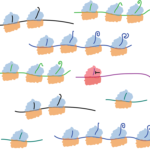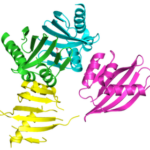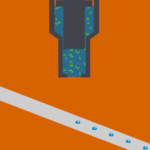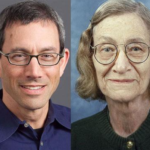The discovery of a chemical compound that halts the production of a small set of proteins while leaving general protein production untouched suggests a new drug search strategy: Find compounds that target undesired proteins before they are even made. In a paper appearing in the journal PLOS Biology, described the work of researchers at the University of California, Berkeley, and Pfizer Worldwide Research and Development. Faculty scientist Jamie Cate, Structural Biology Department Head in the Molecular Biophysics and Integrated Bioimaging Division, was a senior author of this study. Read the full story in Berkeley News.
Designing Protein Cavities from Curved Beta Sheets
Curved beta sheets are important for the architecture of protein cavities, such as enzyme active sites and ligand-binding pockets. Beginning by analyzing classic protein formations and running folding simulations, University of Washington (UW) researchers under the leadership of David Baker designed six protein folds inspired by naturally occurring protein superfamilies. A research report published in the January 13 issue of Science describes how a multi-institutional team of scientists compared the predicted models to physical structures of these designed proteins.
WSEC Champions Workplace Improvements
In honor of National Women’s History Month, Berkeley Lab, in this article, looked back at how the Lab’s Women Scientists & Engineers Council (WSEC) got started and what issues it is currently working on. The WSEC is a program of the Lab’s Diversity and Inclusion Office and was founded in 2008 by what longtime members like to call the “founding mothers”—Natalie Roe of the Physics Division, Nancy Brown of the Energy Technologies Area, and Cecilia Aragon, formerly of the Computational Research Division.
At the moment, WSEC board members from Biosciences include Environmental Genomics & Systems Biology Division’s Astrid Terry and Lauren Lui; Susan Tsutakawa of the Molecular Biophysics & Integrative Bioimaging Division currently serves as the committee chair.
Conveyor Belt Innovation Speeds Up Biological Discovery
Bioscientists Junko Yano, Vittal Yachandra, and Jan Kern led a multi-institutional collaboration to develop and demonstrate a novel Acoustic Droplet Ejection-“Droplet on Tape” method of sample delivery for free electron laser experiments. The study, which was published yesterday in Nature Methods, describes the techniques that were deployed at SLAC’s Linac Coherent Light Source.
Mother and Son Both Elected to National Academy of Sciences
Like mother, like son. In May 2016, Krishna “Kris” Niyogi, who grew up in Oak Ridge, was elected to the National Academy of Sciences (NAS). Eighteen years earlier, in 1998, his mother Audrey, who worked at Oak Ridge Lab for 44 years, was elected to the academy, which is a private, nonprofit organization of the country’s leading researchers.
The NAS recognizes and promotes outstanding science through election to membership; publication in its journal, PNAS; and its awards, programs, and special activities. Through the National Academies of Sciences, Engineering, and Medicine, the NAS provides objective, science-based advice on critical issues affecting the nation. Election to membership in the NAS is considered one of the highest honors that a scientist can receive.
Niyogi, a faculty scientist affiliated with the Molecular Biophysics & Integrated Bioimaging Division, and his mother were recently featured in a “Historically Speaking” post of the Oakridger which includes several quotes of Niyogi.
- « Previous Page
- 1
- …
- 56
- 57
- 58
- 59
- 60
- …
- 78
- Next Page »
Was this page useful?








